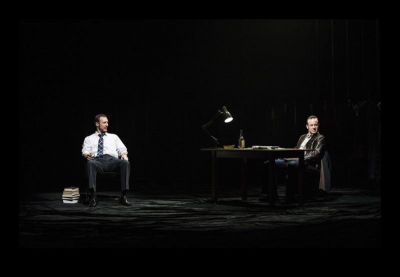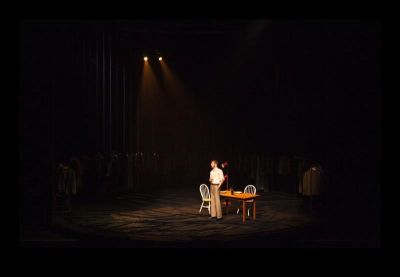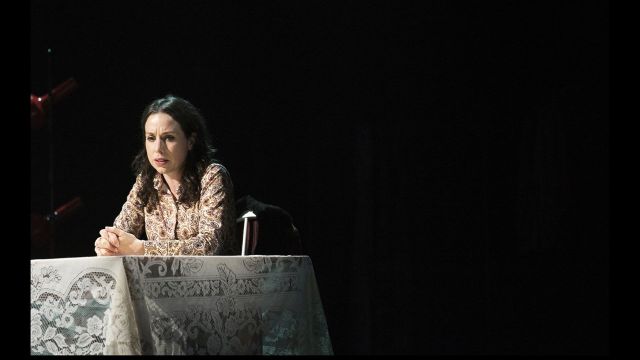Betrayal
Emma (Alison Bell), married to Robert (Mark Saturno), and Jerry (Nathan O’Keefe), married to Judith (never seen), have an affair. The play begins, however, with all passion spent: their affair is cold and over and only awkwardness and deceit linger on. Betrayal is the story of that affair, but told backwards so that, from the start, the question is not ‘what happened’ but ‘how’.
The reverse chronology is not a gimmick (although it was seen as such at the play’s premiere in 1978); in fact, it sharpens the ironies of who deceived and betrayed and who was deceived and betrayed, and when. Pinter’s language has its own almost musical rhythms as the dialogue circles, stops, begins again. Everyday language, apparently banal exchanges, repetitions, conversational stops and starts are all loaded, camouflage for the subterfuges and evasions beneath. Among the copious background texts supplied in the programme, there’s a quote from Pinter himself: ‘…I’ve always been aware that my characters tend to use words not to express what they think or feel but to disguise what they think and feel, to mask their intentions, so that words are acting as a masquerade, a veil, a web…’
 Of course, there is no single, right way to produce any theatre text, but in this production, almost everything – with the exceptions of Pinter’s words and the actors - seems wrong. Perhaps ‘wrong’ is too strong a word, so let’s say ‘puzzling’. Here is a play, surely, that tells a story that could scarcely be more intimate and nuanced. And yet here, in The Sumner, we are distanced from it by a range of production decisions. Geoff Cobham’s design limits and encloses the playing space, but it is still vast – and empty. A clothes rack, on which hang not only the characters’ costume changes, but also numerous other items of clothing as well as furniture and props for scene changes, encircles two thirds of the stage. The intent for this is hard to fathom.
Of course, there is no single, right way to produce any theatre text, but in this production, almost everything – with the exceptions of Pinter’s words and the actors - seems wrong. Perhaps ‘wrong’ is too strong a word, so let’s say ‘puzzling’. Here is a play, surely, that tells a story that could scarcely be more intimate and nuanced. And yet here, in The Sumner, we are distanced from it by a range of production decisions. Geoff Cobham’s design limits and encloses the playing space, but it is still vast – and empty. A clothes rack, on which hang not only the characters’ costume changes, but also numerous other items of clothing as well as furniture and props for scene changes, encircles two thirds of the stage. The intent for this is hard to fathom.
But worse, there is a revolve – a piece of stage machinery surely invented for fast scene changes. Not in this show. At the end of each relatively brief scene (there are eight and the show runs one and a half hours) the revolve revolves. The stage hands and cast are partially hidden behind all those shirts, coats and whatever while they set up the next scene with tables, chairs, bed linen, lamps, crockery and glassware. And what do we do while this goes on? We wait. We shift about and we disengage. Perhaps the disengagement is intentional. Perhaps director Geordie Brookman wants to distance us from these characters. If so, he succeeds. These disruptions are not helped by flashes of blinding light and bursts of Jason Sweeney’s apocalyptic soundscape. Perhaps the sound design has an ironic intent also. The portentous sound of impending catastrophe as a comment on the trivial miseries of these deceitful, middle-class characters? Maybe. But it is puzzling.
In this context, much of that on which Pinter bravely relies, his famous pauses, repressed but fleetingly visible emotions, ambivalences and subtext, struggle to make their contribution to the whole. The famous pauses are certainly there, but so drawn out that you wonder, not if the characters are stymied or groping for the next lie, but if the actors have ‘dried’. As The Companion remarked, ‘I had birthdays during those pauses.’ Interestingly, Pinter himself (older but wiser?) attended rehearsals for a revival in 2007. One piece of his advice to the cast was to ignore a lot of those pauses…
 So here ‘the concept’ works against the actors. Alison Bell’s Emma is a detailed and, I think, very real performance, which for that very reason sometimes disappears. Her character, nevertheless and despite being as duplicitous as the men, elicits the most sympathy, perhaps because the men, when together, exhibit that blokey, not-so-crypto misogynist tone that is no doubt intentionally repellent. Mr O’Keefe and Mr Saturno do not fare quite so well: the production rather reduces Jerry and Robert to cut-outs. Jerry comes across as not much more than a weak, self-serving coward with a fast mouth. Mr Saturno, unfortunately, opts for the fruity and over-emphatic, perhaps, as an experienced actor, attempting to project his Robert out of its reductive confines and into the audience. John Maurice as a waiter, in only one scene, does what’s needed.
So here ‘the concept’ works against the actors. Alison Bell’s Emma is a detailed and, I think, very real performance, which for that very reason sometimes disappears. Her character, nevertheless and despite being as duplicitous as the men, elicits the most sympathy, perhaps because the men, when together, exhibit that blokey, not-so-crypto misogynist tone that is no doubt intentionally repellent. Mr O’Keefe and Mr Saturno do not fare quite so well: the production rather reduces Jerry and Robert to cut-outs. Jerry comes across as not much more than a weak, self-serving coward with a fast mouth. Mr Saturno, unfortunately, opts for the fruity and over-emphatic, perhaps, as an experienced actor, attempting to project his Robert out of its reductive confines and into the audience. John Maurice as a waiter, in only one scene, does what’s needed.
If only the play could have been performed, with this cast, in a less cavernous space, without a revolve – and consequently less clothing and furniture – or a revolve better used - and without effects that seem designed to turn drama into melodrama – as if no one trusted the text. On the other hand, Betrayal works very well as a movie (1983, with Patricia Hodge, Jeremy Irons and Ben Kingsley) in which scene changes take one twenty-fifth of a second...
As I say, puzzling and the more so when we see the extensive and impressive credits of director, designer and sound designer. Ths is, in short, a triumph of concept over content.
Michael Brindley
Photographer: Shane Reid.
Subscribe to our E-Newsletter, buy our latest print edition or find a Performing Arts book at Book Nook.

